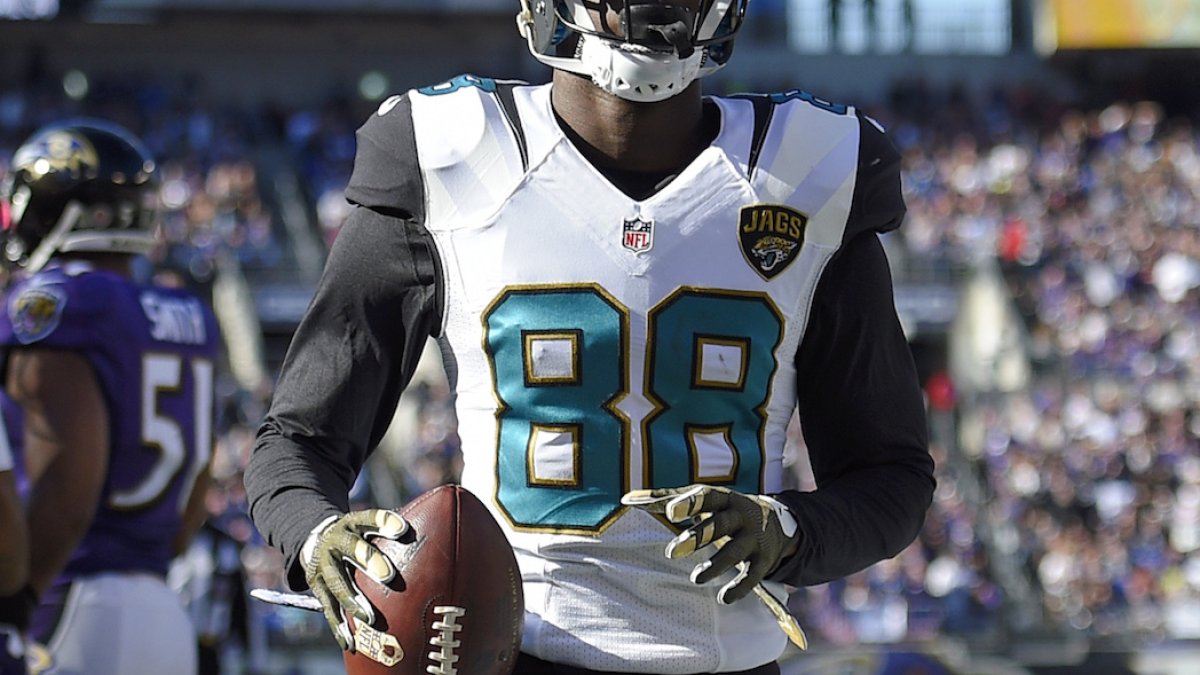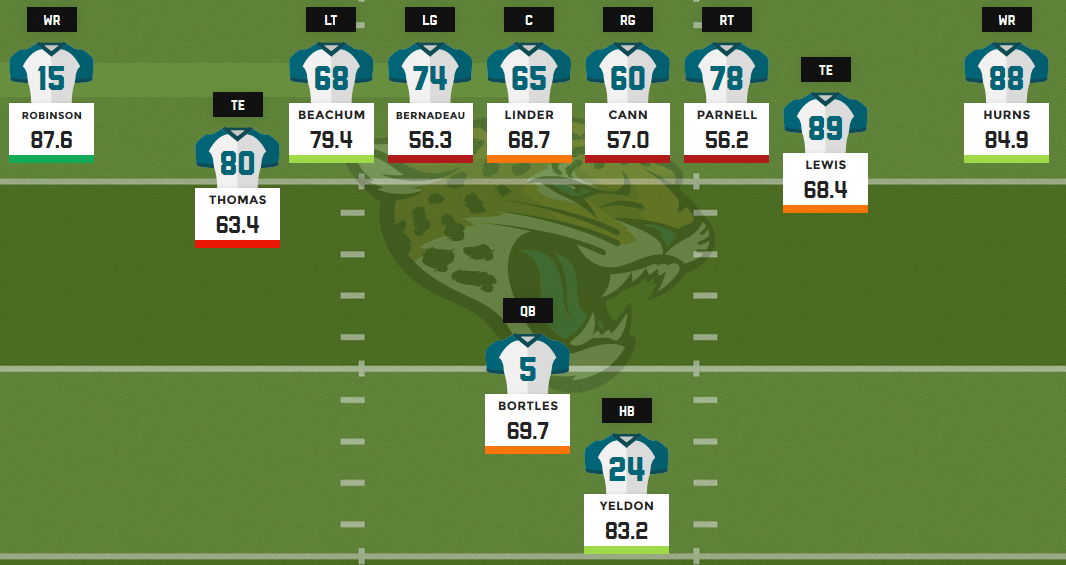(Editor’s note: As we lead up to the season, Director of PFF Fantasy Jeff Ratcliffe is breaking down each team’s depth chart from a fantasy perspective. Catch up on the work so far here.)
The Jaguars took a step forward on the offensive side of the ball last season, averaging 23.5 points per game after managing just 15.6 points per game in 2014. However, Jacksonville won just five games on the season. However, with a potentially improved defense, there are some things to like on this depth chart.
Former first-rounder Blake Bortles is coming off a strong fantasy season, where he finished fourth among quarterbacks in scoring, but he only managed to grade out as our 23rd quarterback. So how'd he do it? Volume. With the Jaguars often playing from behind, Bortles was forced to throw a lot. He was second in dropbacks (685) and sixth in attempts (604). Bortles completed just 58.6 percent of his throws, which was second-lowest among full-time starters. He also led the league in interceptions (18) and sacks taken (51). Bortles struggled in the face of pressure, completing a league-worst 43.1 percent of passes. For fantasy purposes, he padded his numbers with a league-high 97 deep throw attempts, completing 40 for 1,330 yards and 10 scores. It’ll be hard for Bortles to repeat his 35-touchdown performance, and he’s likely to regress from last year’s fantasy production.
The good news is that Bortles will continue to offer big play upside in 2016 with Allen Robinson and Allen Hurns stretching the field. Robinson broke out in a big way last season with a fourth-place finish in standard fantasy scoring. He led the league in deep targets with 47, catching a position-high 19 of them for 672 yards and three scores. In total, 33.1 percent of Robinson's targets were on deep balls, and his average depth of target at 16.3 yards was 10th-highest at the position. The question for fantasy purposes is whether or not Robinson’s arrow will continue to point up? Jacksonville addressed their glaring weakness on the defensive side of the ball in the draft. They also get Dante Fowler back. With an improved defense, the Jags likely won’t need to push the ball downfield as frequently. Still, Robinson’s talent and role in the offense lock him in as a WR1.
Jacksonville Jaguars projected 2016 offense with 2015 grades:
Few expected much out of Hurns as an undrafted free agent, but he worked his way into a starting role as a rookie. And like Robinson, he took a big step forward last season, topping 1,000 yards and double-digit touchdowns on his way to a 14th-place fantasy finish. For his efforts, Hurns was rewarded with a big contract extension this offseason. While his role as a starter opposite Robinson is solidified, it isn’t clear if he can repeat last season’s productivity. Hurns still has plenty of upside, but volume isn’t likely to be as much in his favor.
Rashad Greene is all but solidified as the third receiver. The former Florida State receiver – and Jameis Winston’s favorite target in 2014 – figures to be in the slot in three-wide sets. Greene doesn’t register on the 2016 fantasy radar. Marqise Lee is also in the mix for playing time, but the oft-injured receiver is on the outside looking in at the Jags starting lineup.
At tight end, the Jags have veteran Julius Thomas. While he wasn’t quite able to recapture the fantasy glory he displayed in his time with the Broncos, Thomas was a solid fantasy asset last season. From Week 5 on, he was the No. 11 tight end and tied for the eighth-most targets at the position. His production could have been better, but his six drops tied with Eric Ebron for third-most among tight ends. However, from Jags offseason activities Bortles was quoted saying that Thomas “never drops a ball.” All tropes aside, Thomas should see enough volume to provide back-end TE1 numbers.
At running back, the Jaguars signed veteran Chris Ivory in the offseason, which creates a bit of a predicament for fantasy purposes. Jacksonville leaned heavily on T.J. Yeldon last year, giving the former Alabama running back 218 touches over his first 12 games before a knee injury sidelined him through the end of the season. In the process, Yeldon ranked eighth in forced missed tackles per touch, with one caused on 21.2 percent of his touches. But he was also one of just 10 running backs to not top 1.00 yards per route run as a receiver. No back was asked to pass-block more than Yeldon, with 103 snaps as a pass blocker.
[Do you want Yeldon or Ivory? Ivory or Yeldon? Check out our PFF Draft Master tool and try a mock draft, complete with offensive line grades, full projections and all the PFF data.]
Ivory was one of just seven running backs who topped 1,000 yards rushing last season and he finished seventh among running backs in standard scoring leagues. He tied for third in missed tackles forced with 56, and was one of only five running backs to have more than 40 percent of his yards come on runs of 15-plus yards. He also set a career-high with 30 catches. With Yeldon essentially locked in as the passing down back and likely to get some early-down work, Ivory’s touches will almost certainly decline this season. This true committee situation means we’re unlikely to see better than RB3 production out of either Jags running back.
On the defensive side of the ball, the Jaguars have a lot of exciting young talent. Dante Fowler returns to the field after missing his entire rookie season. The former first-rounder isn’t quite locked in as a fantasy option, but he’s worth monitoring this season. At linebacker, Telvin Smith has surpassed Paul Posluszny as the preferred IDP option, though both are coming off top-10 fantasy seasons. Smith remains locked in as an LB1, but Posluszny’s fantasy arrow is pointing down. He should be considered an LB2 option this season. Keep an eye on John Cyprien at strong safety. There was some chatter earlier in the offseason that he may not keep his starting job. If Cyprien remains in that role, he makes for a DB2 option.



 © 2024 PFF - all rights reserved.
© 2024 PFF - all rights reserved.